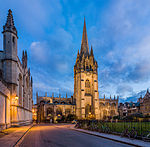All Souls College, Oxford

All Souls College (official name: College of the Souls of All the Faithful Departed) is a constituent college of the University of Oxford in England. Unique to All Souls, all of its members automatically become fellows (i.e., full members of the college's governing body). It has no undergraduate members, but each year, recent graduate and postgraduate students at Oxford are eligible to apply for a small number of examination fellowships through a competitive examination (once described as "the hardest exam in the world") and, for those shortlisted after the examinations, an interview.The college entrance is on the north side of High Street, whilst it has a long frontage onto Radcliffe Square. To its east is the Queen's College, whilst Hertford College is to the north of All Souls. The current warden (head of the college) is Sir John Vickers, a graduate of Oriel College, Oxford.
Excerpt from the Wikipedia article All Souls College, Oxford (License: CC BY-SA 3.0, Authors, Images).All Souls College, Oxford
High Street, Oxford City Centre
Geographical coordinates (GPS) Address External links Nearby Places Show on map
Geographical coordinates (GPS)
| Latitude | Longitude |
|---|---|
| N 51.753279 ° | E -1.253041 ° |
Address
All Souls College
High Street
OX1 4AN Oxford, City Centre
England, United Kingdom
Open on Google Maps









